There is nothing worse than going into your laundry room and smelling a nasty sewer type odor coming up from the floor drain. The good news is that this problem can be fixed easily without having to call a professional plumber out to your home.
Most of the time when you can smell a sewer or sulfur smell coming from the floor drain in your laundry room it is because the trap underground has dried up. By adding a gallon of water down the drain, this will re-prime the trap seal and hold back the sewer gas from entering into your home.
After experiencing this problem last year myself, I wanted to learn more information. I put together a list of the questions I had, and I’d like to share with you what I learned below.
Common Cause for Sewer Smell Coming From a Floor Drain?
There are a few different causes for a sewer smell to be coming from your floor drain. Some of the most common reasons are:
Dry P-trap
Problem: Most of the time the sewer smell is caused because the water in the P-trap has dried up or evaporated. The P-trap is located under your concrete floor, and when it dries up, it will allowing the sewer gases to enter into your home.
Solution: Take a gallon of tap water and dump it down the floor drain. This will re-prime the trap seal and block that nasty sewer gas from getting past.
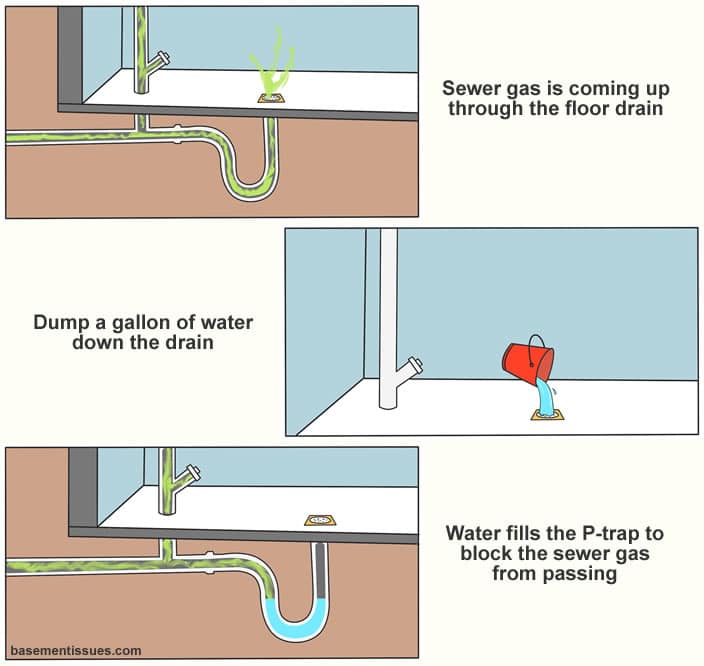
Missing Cleanout Plug
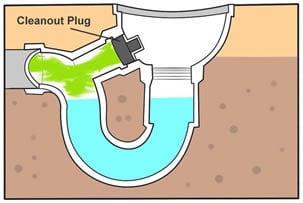 Problem: If you have tried to prime the P-trap, but the smell is still present, another common problem is a missing cleanout plug. If you remove your drain cover and look inside with a flashlight, you will be able to see if your drain is missing a cleanout plug or not.
Problem: If you have tried to prime the P-trap, but the smell is still present, another common problem is a missing cleanout plug. If you remove your drain cover and look inside with a flashlight, you will be able to see if your drain is missing a cleanout plug or not.
Not all floor drains have a cleanout plug. What you are looking for is a second hole that goes down diagonally.
If you are missing a plug, then this is why the sewer gas can bypass the P-trap and enter your home. The image to the right shows a side view of how the cleanout plug works to prevent gases from being able to bypass the trap.
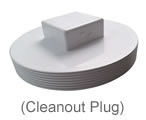 Solution: You can pick up a new cleanout plug from any hardware store that carries plumbing supplies for about $2.00 to $5.00. Cleanout plugs range in different sizes so before you buy one, measure the diameter of the hole so you know which size to get.
Solution: You can pick up a new cleanout plug from any hardware store that carries plumbing supplies for about $2.00 to $5.00. Cleanout plugs range in different sizes so before you buy one, measure the diameter of the hole so you know which size to get.
Bacteria in Riser
Problem: At some point, your pipes might have had a sewer back up that you were unaware of, which left some residue attached to the pipes. Once the sewer backup drained back away, and the level of the water dropped back down to within the trap, this residue over time will turn into a stinky bacteria.
Solution: The best way to get rid of the bacteria that has attached itself to the pipe is to give the riser and nice deep clean.
- Step 1: Remove the drain cover. Needle nose pliers help if you are unable to get a finger under it.
- Step 2: Get an empty bucket and put in 1/4 cup of baking soda, and 3 cups of vinegar. Mix it around within the bucket.
- Step 3: Take a toilet bowl cleaning brush and get it wet using the vinegar and baking soda mix.
- Step 4: Scrub inside the drain, down the riser as far as you can go. Make sure to scrub up and down while you move down the riser. Keep dipping the scrubber into the solution now and then.
- Step 5: Use the scrubber to get right around the drain opening as well. This is a spot that could build up some bacteria.
- Step 6: Dump the remaining bucket of the solution down the drain, and let that sit for a minute.
- Step 7: Finally, take a gallon of water and dump that down the drain to flush everything out.
Warning: Never pour bleach and vinegar together in the floor drain or anywhere for that matter. When you mix bleach and vinegar, this creates a toxic chlorine gas which could lead to a nasty chemical burn, especially in your eyes and lungs.
Why Does Sewer Smell Come And Go?
The reason why a sewer gas smell could come and go is that the water in the P-trap might be evaporating just enough to allow the gas to pass by. After a little while something is running into the drain to refill the water level, and once again block the gas from passing.
Priming the trap by dumping a gallon of water down the drain should help replenish the water level in the P-trap, put if that does not work, you may have a more severe issue with the pipes such as a crack or lose fixing connection.
What is The Floor Drain For And Where Does It Go To?
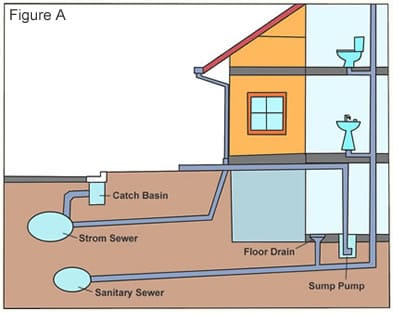 The floor drain is located at the lowest point in the home, usually in a basement or a utility room. The purpose of a floor drain is to serve as an outlet for any water that is leaked onto the floor from a leaky water heater or washing machine overflow.
The floor drain is located at the lowest point in the home, usually in a basement or a utility room. The purpose of a floor drain is to serve as an outlet for any water that is leaked onto the floor from a leaky water heater or washing machine overflow.
There are two possible places where your floor drain connects to.
- The most common in residential houses is that your floor drain connects to a pipe underground that leads to the sanitary sewer system (Shown in figure A).
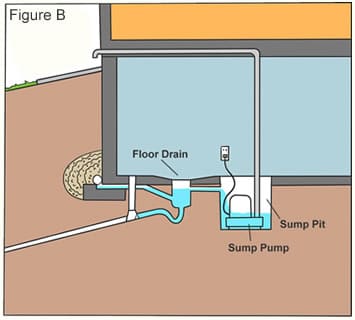 Another possibility is that your floor drain is connected to a sump pit located in your home, which uses a sump pump to remove the collected water from the sump pit and outside of your house where it drains away (Shown in figure B).
Another possibility is that your floor drain is connected to a sump pit located in your home, which uses a sump pump to remove the collected water from the sump pit and outside of your house where it drains away (Shown in figure B).
If your floor drain is connected to a sewer system, you can use it to drain a washing machine, water softener, or laundry sink. However if the floor drain connects to a sump pit, you shouldn’t use it to remove any water that contains salt, chemicals or cleaning detergents.
Is It Harmful To Breathe In a Sewer Gas Smell?
Breathing in that sewer gas smell can be very harmful to your health. Sewer gas is hydrogen sulfide which is caused by decaying organic matter, better known as sewage.
Even a low level of hydrogen sulfide exposure could be dangerous, causing headaches, sinus infections, fatigue, irritability, pneumonia, dizziness, bronchitis, and loss of memory. Both people and pets are at risk if exposed to the sewer gas smell for an extended period.
The more exposure you have to hydrogen sulfide, the more desensitized you begin to come to it, causing you to think the smell has disappeared on its own with you doing anything.
It is not common for a home to have a high level of hydrogen sulfide come up from the floor drain, but if you are exposed to a high level, this could cause sudden death in some individuals.
If you notice a sewer gas smell in your home, it is recommended that you immediately try to fix the problem. As mentioned earlier, the most common solution to fixing this is by adding at least a gallon of water down the drain to refill the trap.
If filling the trap with water does not solve the sewer gas smell, you might have something more serious with your plumbing such as a cracked or deteriorated pipe which is allowing the gas to pass. This would require immediate attention.
How Do You Prevent The Smell From Returning?
It is recommended that you take a gallon of water and dump it into the floor drain every three or four months to make sure that the trap is primed and to help flush out that stagnant water that’s been sitting in there. This is especially important if you find that your basement is dry and the drain doesn’t get very much use.
